Ehmeya is a representative of a large genus from the Bromeliad family, whose central habitat is Central and South America. A distinctive feature of the rosette plants are thorns, on the edges of leaf plates of various colors and structures, depending on the variety. Caring for echmea at home is relatively simple, which makes a tropical plant a welcome inhabitant of urban apartments.
Material Content:
Types and varieties of flower
In the wild, the genus has more than 180 species, of which only a few are grown as potted crops.
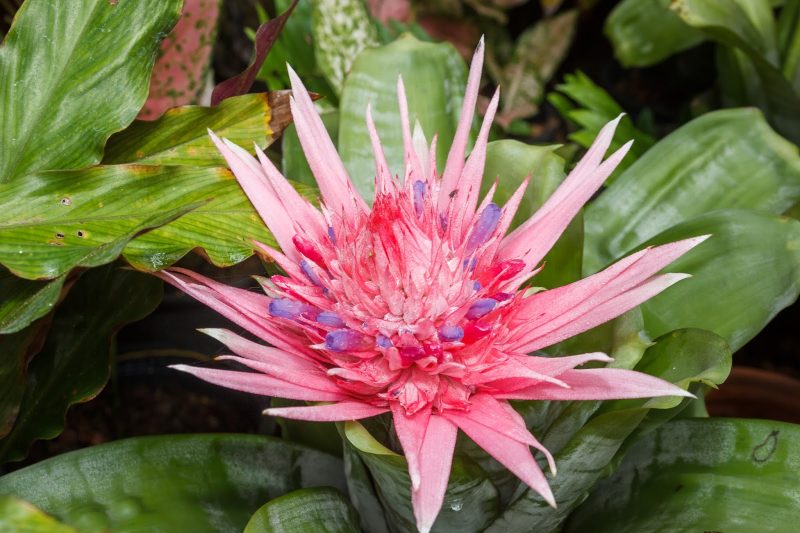
The most common:
- Striped echmea is a large plant with tapered gray-green leaves in a transverse strip, collected in a rosette, the diameter of which reaches 1 m. The capitate-pyramidal inflorescences, consisting of blue flowers, are covered with pink bracts in the lower part.
- Ehmeya Weilbach - the rosette consists of xiphoid reddish-green leaves up to 50 cm long, the edges of which are crowned with small spikes. From the center of the outlet, a high peduncle develops, in the upper part of which the bluish-lilac flowers bloom, collected in a racemose, with bright red bracts.
- Two-rowed echmea is a plant with a loose rosette, the diameter of which can reach 1 m. Green leaf plates at the ends have brown spikes. On a 60 cm long peduncle, lilac flowers bloom with red bracts.A variegated form is also found.
- Ehmea shaggy - represented by strap-like leaves up to 1 m long with rounded edges, covered with short spines. During the flowering period, the formation of an inflorescence-spike, consisting of bright yellow flowers with crimson bracts, is noted.
- Tailed echmea - is distinguished by a yellow fringing of green rosette leaves directed upwards. Golden flowers are collected in inflorescences in the form of a panicle.
- The sparkling ehmea is a variety with green leafy plates, the edges of which are serrated. In the flowering phase, coral red flowers are observed, 100 in inflorescence, with pink bracts. In culture, there is a discolor form, which is distinguished by the non-standard color of the leaves - from the bottom they are painted in lilac red, and from above - olive green.
Ehmeya: cultivation features

When growing ehmei, it is worth considering the needs of the culture, which are:
- a lot of soft light;
- regular additional nutrition through leaf plates;
- plentiful watering;
- increasing humidity.
Optimal flower conditions
In order for an exotic flower to feel comfortable in an apartment environment, it is necessary to create appropriate conditions of detention.
Lighting and location
Like many other tropical representatives, being under the crowns of trees, the echmea loves a large amount of soft light. It is best to place a flower pot near the east or west windows. If this is not possible, then you can install the plant on the south side, organizing protection from direct sunlight at noon.

Advice! In summer, you can take the plant to fresh air, but this should be done gradually so that the leaf plates do not get burns.
Temperature
For better growth and the onset of the flowering phase, it is necessary to correctly organize the temperature regime:
- In the summer season, the temperature value can vary between 22-26 ° C.
- With the advent of cold weather in the room where the flower is contained, it is also recommended to lower the temperature by 7 °.
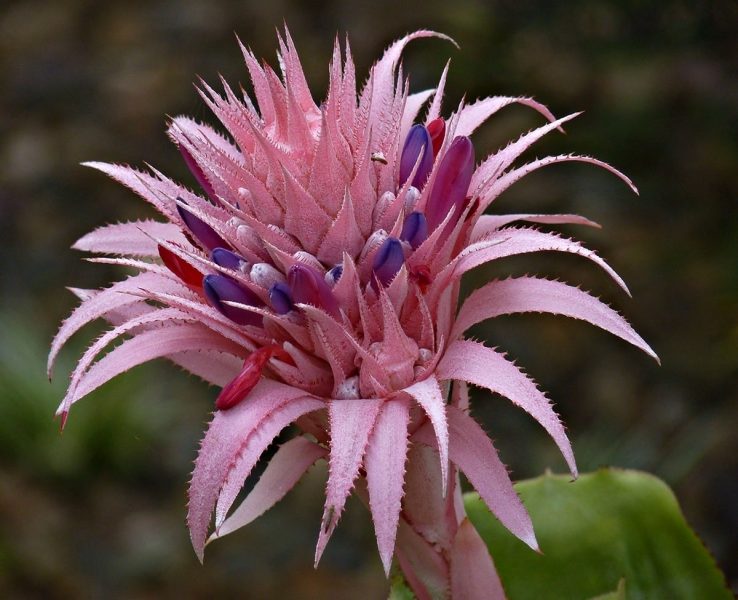
During the day, fluctuations between daytime and nighttime temperatures stimulate the formation of a peduncle. Also, the development of culture requires a constant influx of fresh air. But at the same time it is impossible to allow the presence of echmea in a draft.
Ground and pot requirements
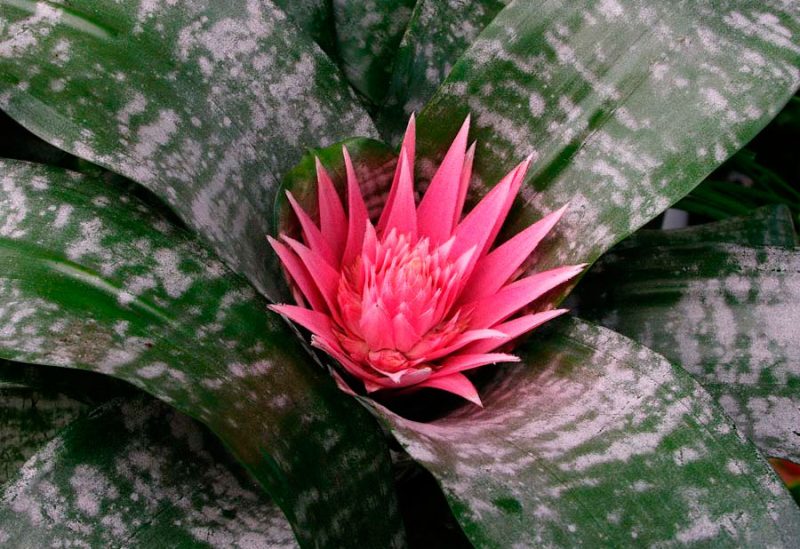
Due to the superficial and undeveloped measles system, the flower needs a wide and low pot. Soil for cultivating a representative of the tropical flora requires a light, slightly acidic reaction. For these purposes, a substrate prepared from sheet soil, peat and sand in a ratio of 2: 1: 1, or a ready-made universal soil purchased in a flower shop, is suitable.
Home Care
Of all the bromeliads, echmea is considered the most unpretentious, but this does not mean that it does not require a systematic and comprehensive care.
Watering
At home, an echmea flower is watered abundantly in two ways: into the ground and into a power outlet. Moisturizing water is taken purified and warm.

Irrigation system depends on the development phase:
- During the period of active vegetation, immediately after the drying of the upper layer, the moisture reserves are replenished with a new portion of the liquid in the two above-mentioned ways.
- With the advent of autumn, the frequency of soil moisture decreases, and water does not pour into the outlet at all.
Caution! You can not water the echmea through a wall outlet in a state of stagnation and after flowering: there is a big risk of intensive development of rot.
Air humidity
Ehmeya easily adapts to dry air in apartments. However, it will be grateful for the increase in humidity by spraying or placing a container filled with water next to the culture.

Attention! You can spray a tropical flower only with warm water.
Top dressing
Full-fledged care for the tropical representative provides for systematic foliar feeding with the help of liquid mineral complexes:
- in the spring-summer period - twice a month;
- in the fall - monthly;
- in winter - once every 1.5 months.
Ehmei transplant
The bromeliads do not have an urgent need for systematic transplants, since due to the underdevelopment of the roots, obtaining nutrients is little dependent on the substrate.
If a transplant is still needed, it is carried out as follows:
- A new pot is being selected.
- A drainage layer is placed at the bottom of the tank.
- Suitable for growing bromeliad soil is poured on top.
- By transshipment, a flower moves.
- The void is filled with a prepared substrate.
Flowering plants
To stimulate flowering, bromeliads need ethylene, which is secreted from apples and bananas.
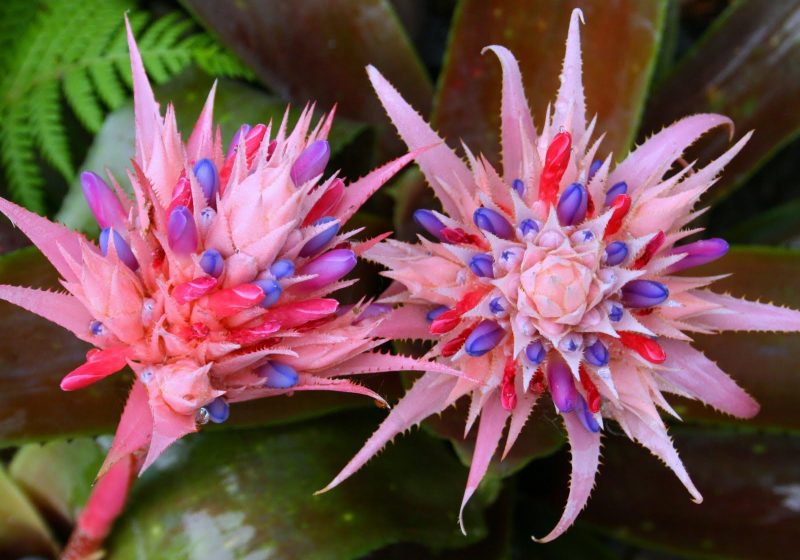
To prevent gas from escaping, it is necessary:
- Place an apple and a banana next to the pot.
- Cover with a package and keep in this form for 2 weeks.
After 4 months, the peduncle will begin to develop.
Pest and disease protection

The pests that can inhabit the plant include aphids, scale insects, and root bugs. If one of them is found, it is worth spraying the shoots with an insecticide. Among the diseases, gray rot is sometimes noted. The impetus for its development is an excess of moisture, the prevention of which is the best protective measure.
Methods of propagation of ehmei
An exotic plant propagates both vegetatively and with the help of seeds.
Seed way
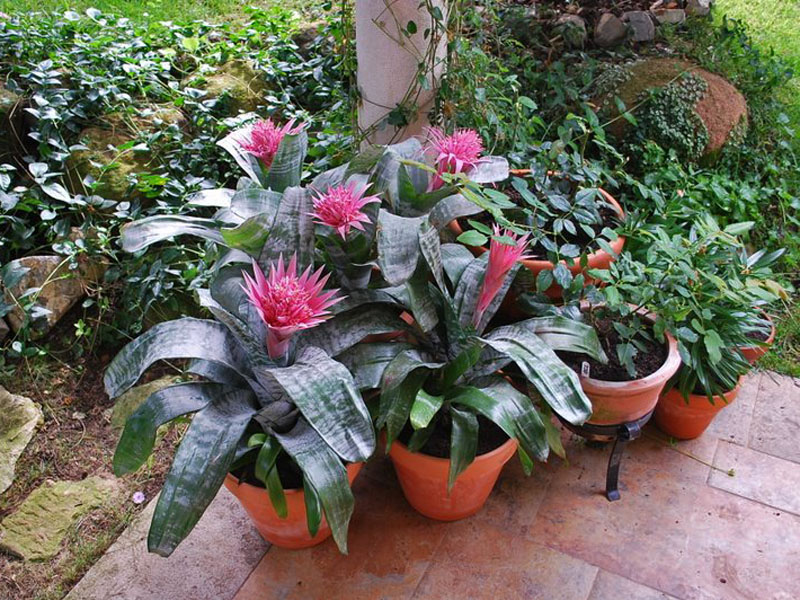
A rather time-consuming process in which to obtain a positive result, you must adhere to the following scheme:
- The seedling tank is filled with peat and moss.
- Seeds are distributed on the surface of the moistened substrate.
- The box is covered with polyethylene and moved into a warm, shaded room.
- The film is systematically removed for irrigation and ventilation.
- After 3 months, when 4 true leaflets are formed in the emerging seedlings, the seedlings dive into a mixture of leafy soil and needles.
- After a year, stronger seedlings are planted in individual containers.
Propagation by offspring
If the flower grower already has echmea, then it is better to propagate it in a vegetative way, which is carried out in early spring:
- The most developed offspring are selected.
- Children are separated with a sharp, sterile knife.
- Places of cuts are processed by charcoal.
- The processes are planted in separate, shallow containers filled with a special substrate.
- For speedy rooting, the container is covered with a package that is removed for ventilation and moisturizing.
Precautions: poisonous ehmei
Ehmeya is a poisonous plant. Contact with it may cause irritation on the skin. To avoid discomfort and other unpleasant situations, when working with a flower, protect your hands with rubber gloves.

Thus, if a florist decided to acquire an exotic flower, but has not yet made a choice in favor of a particular one, then it is better to take a closer look at the ehmei, which fits perfectly into any interior and does not require too much attention.












